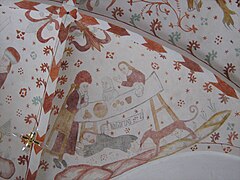Fanefjord Kirke
The Fanefjord Kirke is located in the far west on the Danish island of Møn , visible from afar on a hill at the end of the Fanefjord, a kind of fjord . It belongs to the Diocese of Roskilde, the Evangelical Lutheran People's Church in Denmark .
The Fanefjord got its name after the nearby, almost 100 m long long bed "Grönsalen" . A queen named Fane is said to be resting under the western stone, and her husband Grøn the hunter under the eastern stone .
Architecture and equipment
The church is a brick building and consists of the nave , a tower in the west and a vestibule in the north. The walls are whitewashed on the outside, the roofs of the nave and tower are covered with red tiles.
The unusually large ship with a side wall height of about 7 m dates from the last half of the 13th century. It has an older west side and a younger east part closed on three sides. Originally a narrower choir was attached to the nave , the position of which is still recognizable on the east side of the triumphal arch. After 1500, when the nave was lengthened in the late Gothic style , this choir was replaced by the current one, and the tower and porch were added. The nave and the tower have high straight stepped gables . The tower has three floors, the bell storey has two narrow sound holes on all four sides.
Three pillars divide the nave into two naves and four bays. Even if today's vaults only come from the renovation around 1500, the church was probably vaulted from the beginning. Only the window in the western yoke of the northern nave is original, the other windows are from the late Gothic renovation.
The altar table is new, the late Renaissance altarpiece is from 1634, the pulpit from 1645. The baptismal font is late Romanesque and from Gotland, the baptismal bowl from 1956.
Frescoes
The church has frescoes from two periods. The paintings on the triumphal arch date from around 1350; the paintings on the vault and on the walls and pillars come from the so-called Elmelunde master and his workshop from around 1500, they are the main attractions of the church.
The frescoes were whitewashed after the Reformation, rediscovered in 1927, exposed from 1929 to 1931 and restored between 1932 and 1934 and then again from 2008 to 2009.
A brochure displayed in the church describes the frescoes and the historical inventory in German.
Web links
Individual evidence
- ↑ Fanefjord Kirke (Danish), accessed September 14, 2019.
Coordinates: 54 ° 54 ′ 4.5 " N , 12 ° 9 ′ 3.9" E











